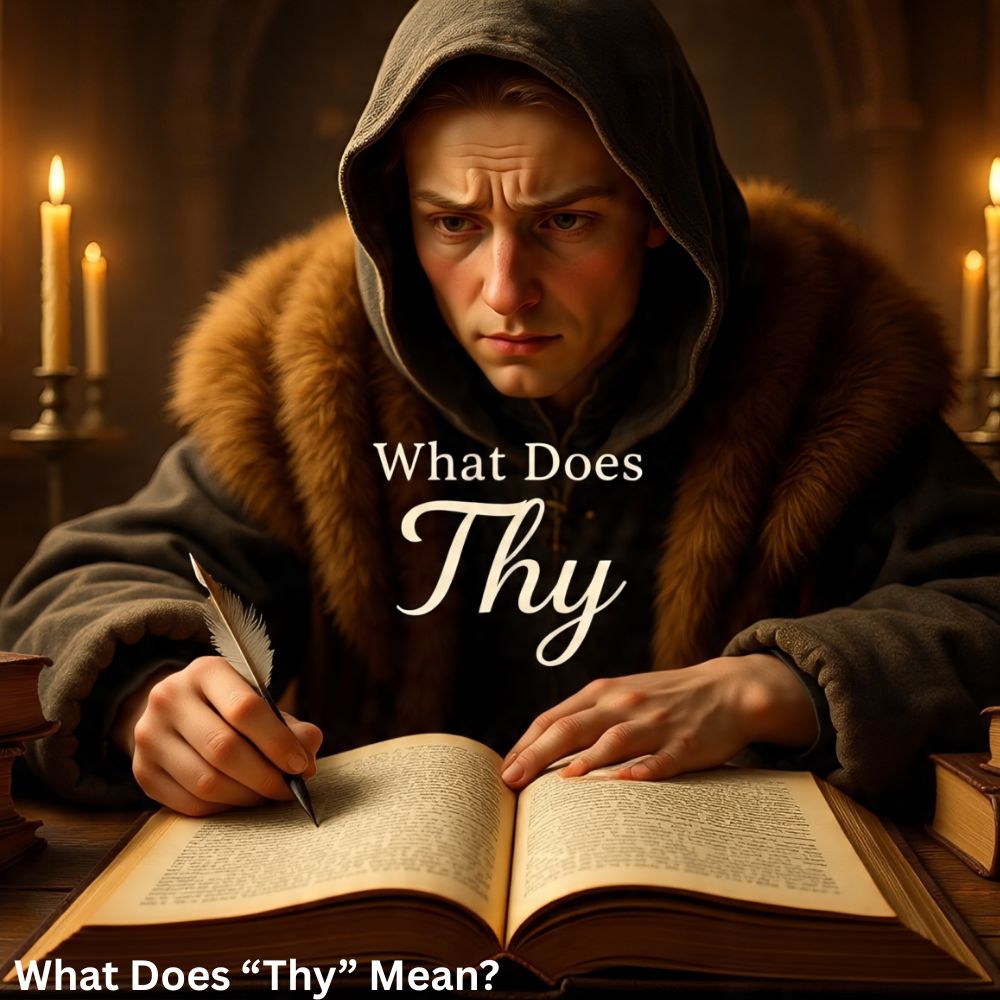Language changes over time. Words that were common centuries ago may now seem unusual or poetic. One such word is “thy.” It is an old-fashioned pronoun that was used frequently in English literature and religious texts.
You may have seen “thy” in Shakespeare’s plays, historical documents, or the King James Bible. It is a form of “your” used when speaking to someone in a personal or respectful way. Understanding this word helps us connect with older texts and appreciate how English has evolved.
Although “thy” is rarely used in modern speech, it still appears in literature, poetry, and religious writings. Knowing its meaning and use gives insight into historical language and can make reading classic works easier and more enjoyable.
What Does “Thy” Mean?

“Thy” is an old English word that means “your.” It was used to show possession, just like we use “your” today. This word was common in the Middle Ages and in early modern English.
In simple terms:
- Thy = your (used before a noun).
- Example: Thy book = Your book.
There is a small rule to remember. “Thy” is used before words that begin with a consonant sound. For words starting with a vowel, the word “thine” is used instead.
- Example: Thy house (consonant)
- Example: Thine apple (vowel)
This pattern is similar to how we use “a” and “an” in modern English. Knowing this helps you read historical texts with more understanding.
The Origin and Evolution of “Thy”
The word “thy” comes from Old English. In Old English, it was written as “þīn” (pronounced “theen”) and was the possessive form of “þū”, which meant “thou” or “you.” This shows that “thy” has been part of English for over a thousand years.
During the Middle English period (12th–15th centuries), the spelling changed to thy and thine. People used these forms regularly in speech and writing. At the same time, the word you started to replace thou in everyday conversation, but thy remained as the singular possessive form.
In the Early Modern English era (16th–17th centuries), writers like Shakespeare and translators of the King James Bible used thy extensively. It became common in literature, poetry, and religious texts. This period helped standardize its use in writing, even though spoken English was already shifting.
By the 18th century, English gradually moved toward using your for both singular and plural forms. This made thy mostly poetic or religious. Today, thy is rare in daily conversation but survives in literature, hymns, and historical texts.
Timeline of “Thy” evolution:
- Old English (5th–11th centuries): þīn was the standard possessive form of þū.
- Middle English (12th–15th centuries): thy and thine became common; you began replacing thou.
- Early Modern English (16th–17th centuries): thy widely used in literature and religious texts.
- Modern English (18th century onward): your replaced thy in normal speech; thy remained in poetry and formal writing.
Understanding this evolution helps us see how English grammar and vocabulary have changed over time. It also explains why thy appears in older texts but feels unusual today.
Is “Thy” a Slang, Acronym, or Name?
“Thy” is not slang. It is not an acronym either. It is a genuine historical English word that was used as a possessive pronoun, meaning “your.” People used it to speak directly to someone in a respectful or personal way.
Today, “thy” can appear in a few modern contexts, but its original meaning is usually not the main focus. For example, in Vietnam, Thy is a popular female name. It often means “poetry” or “poem” and is completely unrelated to the English pronoun.
In specialized fields, “thy” may appear as a short form of medical words like thyroid in notes or records. Some creative projects, brands, or art names also use “thy” to give a vintage or poetic feeling.
Even though it can appear in names or abbreviations, the word thy still carries its historical identity in literature and religious texts. Knowing these different uses helps us understand both the old and modern appearances of the word.
“Thy” Pronunciation & Spelling
Understanding how to pronounce and spell “thy” is important for reading older texts and appreciating historical English. Here are the key points:
- Pronunciation:
- Pronounced /ðaɪ/.
- Rhymes with “my” and “sky.”
- The “th” sound is voiced, like in “this,” not like in “thin.”
- Pronounced /ðaɪ/.
- Old English spelling:
- Written as þīn using the letter thorn (þ) for the “th” sound.
- The pronunciation was very similar to today’s “thy.”
- Written as þīn using the letter thorn (þ) for the “th” sound.
- Middle English variations:
- Seen as thin or thyn in manuscripts.
- Spelling was not fixed, so writers often used different forms.
- Seen as thin or thyn in manuscripts.
- Early Modern English:
- Standardized as thy in literature and religious texts.
- Used widely in works by Shakespeare and Bible translations.
- Standardized as thy in literature and religious texts.
- Modern English usage:
- Rare in everyday writing.
- Still appears in poetry, hymns, fantasy literature, and historical performances.
- Rare in everyday writing.
- Why it matters:
- Knowing correct pronunciation preserves the rhythm of classic texts.
- Understanding historical spelling helps in reading manuscripts and old books accurately.
- Adds appreciation for the evolution of English language over centuries.
- Knowing correct pronunciation preserves the rhythm of classic texts.
How People Use “Thy” Today
Even though “thy” is old-fashioned, it is still used in certain contexts:
- Religious Texts: Common in older Bible translations to show respect or devotion.
- Literature & Poetry: Adds a classic or poetic tone in writing.
- Theatre & Performances: Used in Shakespearean plays and historical dramas for authenticity.
- Fantasy & Games: Appears in medieval or magical settings to create atmosphere.
- Pop Culture: Occasionally used in memes or parodies for dramatic or humorous effect.
Examples of “Thy” in a Sentence
- Honor your parents and treat them with care.
- Keep your promises, for they show your character.
- Guard your heart against anger and pride.
- Speak your thoughts clearly and honestly.
- May your days be filled with peace and happiness.
- Take care of your home and belongings.
- Let your actions reflect kindness and patience.
- Protect your family and loved ones from harm.
- Seek wisdom and grow in understanding.
- Remember your duties and responsibilities each day.
Other Possible Meanings of “Thy”
Apart from being an old English pronoun, thy can appear in different ways today:
- Personal Name: In Vietnam, Thy is a common female name meaning “poetry” or “poem.”
- Medical Abbreviation: Sometimes used as short form for thyroid in medical notes.
- Brand or Artistic Name: Used in businesses, art, or projects to give a poetic or vintage feel.
- Informal Shortcuts: Rarely, people may write thy as a quick form of “they” in notes or messages.
These meanings show that while the original grammatical use is historical, the word still appears in modern names, writing, and specialized contexts.
Words and Acronyms Related to “Thy”
Thou – Old English singular form of “you.”
Thee – Old English object form of “you.”
Thine – Archaic form of “yours,” used before vowels or alone.
Thyself – Means “yourself” in older English.
Your / Yours – Modern equivalents of thy and thine.
Is “Thy” in the Dictionary?
Yes, thy is included in major dictionaries such as Oxford, Merriam-Webster, and Cambridge. It is defined as an archaic possessive pronoun meaning “your.” Although it is rarely used in everyday speech today, dictionaries note its presence in literature, poetry, and religious texts, highlighting its historical and cultural significance.
Better Alternatives to Say “Thy”
In modern English, thy can be replaced with words that are easier to understand. The most common alternative is your, which works in almost every sentence. Yours can be used when referring to something at the end of a sentence. In more formal or descriptive writing, phrases like belonging to you or of you can also be used. These alternatives keep the meaning clear while making the language simple. Writers may still choose thy in poetry, literature, or historical contexts to add a classic or poetic tone.
Cultural and Generational Impact of “Thy”
The word thy connects readers to the history of the English language. Older generations often encounter it in religious texts, classic literature, and traditional hymns. It gives a sense of how people spoke in the past.
For younger readers, thy is usually seen in school lessons or historical stories. It helps them understand the style and rhythm of older English. Learning it also makes reading Shakespeare and other classical works easier.
Why It’s Important to Know These Words
Knowing words like thy helps us understand historical texts, literature, and religious writings. It also shows how the English language has changed over time. Learning these words makes reading classic works easier and allows writers to use them for a poetic or formal effect when needed.
The Future of the Word “Thy”
The word thy is unlikely to return to everyday speech, but it will continue to appear in literature, poetry, religious texts, and historical performances. It also survives online in memes and creative writing, keeping its presence alive for those who enjoy classic and poetic language.
FAQs
What does “thy” mean?
Thy is an old English word meaning “your”, used to show possession.
Is “thy” still used today?
It is rarely used in daily speech but appears in literature, poetry, and religious texts.
How is “thy” different from “thine”?
Thy is used before words starting with consonants, while thine is used before vowels or alone.
Can I use “thy” in modern writing?
Yes, it can add a poetic, formal, or historical tone to your writing.
Where did “thy” come from?
It comes from Old English þīn, the possessive form of þū, meaning “thou” or “you.”
Conclusion
Thy is a small but meaningful word that connects us to the history of English. It appears in literature, religious texts, and poetry, helping readers understand older styles of language.
Even though it is not common in everyday conversation, knowing thy enriches reading classic works and adds a poetic or formal touch to modern writing. Its presence continues to preserve the beauty and rhythm of historical English.







